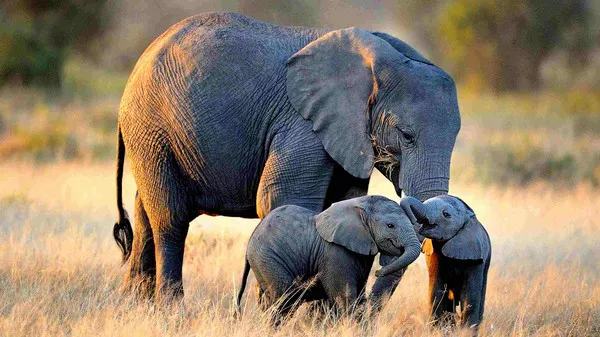Africa’s vast and diverse landscapes are home to some of the most iconic and awe-inspiring creatures on the planet. Among them, the Big Five mammals hold a special place in the hearts of wildlife enthusiasts and conservationists alike. These magnificent animals – the African elephant, African lion, African leopard, African buffalo, and rhinoceros – symbolize the continent’s rich biodiversity and serve as ambassadors for its natural heritage.
Africa’s Big Five
The term “Big Five” originated from the days of colonial trophy hunting when big-game hunters sought to bag the most challenging and dangerous animals to hunt on foot. Today, however, the Big Five represent Africa’s flagship species and play a vital role in the continent’s ecosystem dynamics. Their conservation is not only essential for maintaining ecological balance but also for supporting local economies through tourism and fostering a sense of pride and identity among African nations.
Africa’s Big 5 Mammals
1. The African Elephant
Standing tall as the largest land mammal on Earth, the African elephant (Loxodonta africana) is an emblem of strength, intelligence, and familial bonds. These majestic creatures roam the grasslands, forests, and savannas of sub-Saharan Africa, where they play a critical role in shaping their habitats through feeding and migration patterns.
African elephants are highly social animals, living in tight-knit family groups led by matriarchs – the oldest and most experienced females. Their sophisticated communication, characterized by a wide range of vocalizations, body language, and tactile cues, enables them to navigate their surroundings and maintain social cohesion.
Despite their formidable size and stature, African elephants face numerous threats, including habitat loss, poaching for ivory, and human-wildlife conflict. Conservation efforts focused on protecting elephant populations and their habitats are essential for ensuring the survival of these iconic giants for future generations to cherish and admire.
2. The African Lion
Renowned for their regal presence and fearsome roar, the African lion (Panthera leo) reigns supreme as the undisputed king of the savanna. These majestic predators inhabit a wide range of habitats across Africa, from open grasslands to dense woodlands, where they form prides – social groups consisting of related females, their offspring, and a coalition of dominant males.
African lions are apex predators, playing a crucial role in regulating prey populations and maintaining ecosystem balance. Their hunting prowess, characterized by coordinated ambushes and stealthy stalks, has earned them a reputation as formidable predators capable of taking down large prey such as wildebeest, zebra, and buffalo.
Despite their status as apex predators, African lions face significant threats, including habitat loss, human-wildlife conflict, and poaching for traditional medicine. Conservation initiatives aimed at protecting lion populations and promoting coexistence with local communities are vital for safeguarding these majestic creatures and preserving Africa’s iconic savanna landscapes.
3. The African Leopard
Slinking through the shadows with unparalleled grace and agility, the African leopard (Panthera pardus) epitomizes stealth and adaptability in the African wilderness. These elusive big cats inhabit a diverse range of habitats, including forests, savannas, and mountainous regions, where they rely on their cryptic coat patterns and nocturnal habits to evade detection.
African leopards are solitary and territorial animals, with each individual occupying a home range that overlaps with those of neighboring leopards. Their solitary nature is complemented by exceptional hunting skills, enabling them to stalk and ambush a wide variety of prey, including antelope, small mammals, and even larger species like impala and warthogs.
Despite their elusive nature, African leopards face significant threats, including habitat loss, poaching for their pelts, and retaliatory killings by livestock owners. Conservation efforts focused on mitigating human-wildlife conflict and protecting leopard habitats are crucial for ensuring the long-term survival of these magnificent felines in the wild.
4. The African Buffalo
Forming vast herds that traverse the savannas in search of grazing opportunities, the African buffalo (Syncerus caffer) stands as a symbol of resilience and communal strength in the face of adversity. These formidable bovines are well-adapted to life on the African plains, where they play a vital role in shaping ecosystems through grazing and seed dispersal.
African buffalo live in large herds comprised of females, calves, and subadult males, with older males often solitary or forming small bachelor groups. Their hierarchical social structure and collective defense mechanisms make them formidable opponents for predators, including lions and hyenas, which often target vulnerable individuals or weak calves.
Despite their formidable defenses, African buffalo face threats from habitat loss, disease, and poaching for their meat and hides. Conservation efforts aimed at protecting buffalo populations and their habitats are essential for maintaining the ecological integrity of savanna ecosystems and preserving the iconic landscapes they call home.
5. The African Rhinoceros
With their prehistoric appearance and armored exteriors, the African rhinoceros (Diceros bicornis and Ceratotherium simum) embodies resilience and endurance in the face of modern challenges. These magnificent creatures are divided into two species – the critically endangered black rhinoceros and the vulnerable white rhinoceros – both of which face threats from poaching and habitat loss.
African rhinoceroses are solitary and territorial animals, with each individual carving out a niche within its preferred habitat. Their iconic horns, coveted for their supposed medicinal properties in traditional Asian medicine, have made them prime targets for poachers, driving populations to the brink of extinction.
Conservation efforts aimed at protecting African rhinoceros populations have intensified in recent years, with initiatives focused on anti-poaching patrols, habitat restoration, and community engagement. Despite the challenges they face, African rhinoceroses serve as poignant symbols of hope and resilience in the fight against wildlife crime and habitat destruction.
Conclusion
In the vast expanse of Africa’s savannas, the Big Five mammals stand as guardians of the continent’s natural heritage, symbolizing its rich biodiversity and cultural significance. From the majestic elephants and lions to the elusive leopards and resilient buffalo, these iconic creatures capture the imagination and inspire awe in all who encounter them.
Yet, amid the splendor of Africa’s wilderness, the Big Five face mounting threats from habitat loss, poaching, and human-wildlife conflict. Conservation efforts aimed at protecting these magnificent animals and their habitats are more critical than ever, requiring collaboration and commitment from governments, conservation organizations, and local communities alike.
As stewards of Africa’s natural legacy, we must strive to ensure a future where the Big Five roam freely across the savannas, enriching our lives and reminding us of the inherent value of wild places and wild creatures. By safeguarding the habitats and ecosystems that sustain them, we can secure a brighter future for Africa’s iconic mammals and preserve the irreplaceable treasures of the continent’s wilderness for generations to come.
You Might Be Interested In:


























